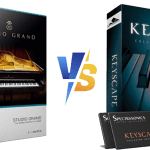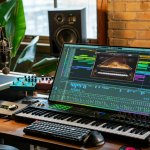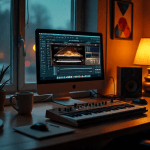Introduction
In the evolving world of digital marketing, visuals may grab attention — but music holds it. In 2025, social media feeds are noisier than ever, packed with short-form videos, influencer campaigns, and automated ad content. Amid all that, brands are rediscovering an old truth with a new twist: the right soundtrack can define the entire emotional landscape of a post.
Royalty-free music remains the backbone of video marketing for businesses and creators who need high-quality, legal sound without licensing nightmares. But today, the rise of AI-generated music is rapidly changing how content producers approach sound. The question is no longer whether to use music — but what kind of music best represents your brand.
This review-style update examines how royalty-free music continues to shape engagement on social platforms, how AI is challenging it, and what marketers can do to strike the right balance between authenticity, legality, and innovation.
How Music Shapes Brand Identity and Engagement
Music isn’t just background noise — it’s emotional architecture. Studies continue to show that adding music to social media videos can increase viewer engagement by over 10x compared to silent posts. The reason is simple: humans process music emotionally before they even think rationally.
An upbeat track can make a brand feel youthful and confident; a cinematic soundscape can add gravity and polish to even a simple product clip. Platforms like TikTok, Instagram Reels, and YouTube Shorts are built on this psychology. Their algorithms reward content that drives watch time, and nothing holds attention quite like well-chosen music that aligns perfectly with the mood of the visuals.
Sonic branding — the use of recognizable audio cues or motifs — has become just as vital as a logo or color palette. Think of Netflix’s “ta-dum” or the gentle pulse of startup jingles in tech ads. Whether a post aims to entertain, educate, or sell, the right music builds recall. Royalty-free tracks make this accessible to every creator, not just major brands.
The Evolution of Royalty-Free Music
A decade ago, royalty-free music had a reputation for being generic — endless loops of ukuleles, stock piano riffs, and uninspired corporate jingles. But the landscape has evolved dramatically. Today’s libraries feature world-class production, genre depth, and even track stems for remixing.
Leading royalty-free platforms now provide crystal-clear licensing, global commercial rights, and broad search filters for mood, genre, tempo, and even instrumentation. Subscription models have made professional soundtracks more affordable than ever, while supporting independent composers through fair revenue sharing.
More importantly, the licensing confidence these libraries provide is gold for marketers. When every track is cleared for commercial use, brands can focus on creativity instead of copyright anxiety. That peace of mind — combined with artistic variety — keeps royalty-free music at the core of modern content creation.
The Arrival of AI Music: The Game Changer or Gimmick?
AI-generated music has exploded onto the scene in 2024–2025, with tools like Udio, Suno, and Soundraw promising instant, customizable compositions from simple text prompts. Type “energetic pop intro for fashion reel,” and within seconds, AI delivers a polished track ready to sync with your visuals.
The appeal is undeniable: it’s fast, inexpensive, and endlessly flexible. Some AI tools now generate entire song structures with verses and choruses in full 48kHz, 32-bit studio quality. For social media creators under time pressure, it’s like having a composer on standby 24/7.
However, this technology comes with caveats. While AI excels at generating functional background tracks, it often struggles with the emotional subtlety that makes human-composed music resonate. Critics describe much of it as “technically impressive but emotionally flat” — perfectly structured yet lacking soul.
There are also unresolved legal and ethical concerns. Major labels have filed lawsuits against AI music platforms for training on copyrighted material without consent. The U.S. Copyright Office has declared that fully AI-generated works lack “human authorship,” meaning they may not be legally protected. For marketers, that means a potential minefield: your AI-generated jingle could be flagged, demonetized, or removed months later if its origins are disputed.
In short, AI music is fascinating technology — but not yet a stable foundation for long-term brand identity.
Royalty-Free vs AI Music: A Balanced Comparison
| Category | Royalty-Free Music | AI-Generated Music |
|---|---|---|
| Cost | Subscription or one-time fee; predictable licensing | Often free or low-cost with paid tiers; very affordable |
| Quality | Professionally composed by musicians; deep emotional range | Rapidly improving but often lacks nuance and human feel |
| Licensing Safety | Clear commercial rights and legal protection | Legally ambiguous; subject to copyright disputes |
| Customization | Limited to editing or mixing stems | Fully customizable via text prompts (genre, tempo, emotion) |
| Ethics | Supports human artists and fair compensation | Often trained on unlicensed datasets; ethical grey area |
| Brand Authenticity | Trusted and human-made; builds emotional connection | May feel synthetic or impersonal if used excessively |
The verdict? AI music is a brilliant production assistant, but royalty-free tracks remain the reliable, emotionally rich choice for serious marketing. The best results often come from combining both — using AI for ideation or placeholders and royalty-free music for final delivery.
Avoiding Copyright and Platform Policy Pitfalls
The rules around music usage on social media are tightening. YouTube’s updated Partner Program now flags “inauthentic AI-generated content,” while TikTok and Meta require labeling for AI-generated audio in commercial posts. Failing to disclose can lead to content removal or loss of monetization.
By contrast, licensed royalty-free music offers rock-solid legal clarity. When you download a track from a trusted library, you get a license certificate that protects you from Content ID claims and takedowns. For businesses and influencers whose income depends on video reach, this reliability is invaluable.
Marketers should view licensing not as a technicality but as brand insurance. It’s not worth risking a takedown over a catchy but unlicensed loop. Stick with vetted platforms — your reputation and SEO depend on it.
The Ethics of Music Choice
Beyond legality lies the question of authenticity. The use of AI-generated music has triggered industry-wide debate about artist compensation and creative ownership. Many AI systems are trained on millions of human compositions without consent, effectively sampling artistry without attribution.
When brands choose royalty-free human-made tracks, they’re not just buying sound — they’re supporting real composers who make a living through their work. That decision carries ethical weight, especially as audiences become more aware of AI’s role in media production.
A recent survey found that over 60% of consumers trust brands more when they use human-created content. The message is clear: authenticity resonates. Whether or not AI music becomes mainstream, it should enhance, not replace, human creativity.
Finding the Right Sound for Your Brand
Selecting music for your social media posts is as much about psychology as it is about style. The key is alignment: your track should mirror your brand personality and the emotion you want to convey.
If your brand exudes confidence and innovation, try modern electronic or cinematic tracks. For warmth and trust, acoustic or lo-fi beats work beautifully. Many royalty-free sites now offer AI-assisted search filters to help you refine your mood, tempo, and instrumentation, making the process faster and more intuitive than ever.
Recommended Royalty-Free Music Platforms
If you’re ready to elevate your audio identity, explore a few trusted royalty-free platforms. Each offers extensive libraries, commercial licensing, and affordable plans:
- Pond5 – One of the best royalty-free music sites for filmmakers and content creators, Pond5 offers an enormous library of cinematic music, royalty-free sound effects, and stock footage. With flexible music licensing for commercial use, it’s ideal for creators producing documentaries, ads, or YouTube videos who need professional-quality audio and visual assets under one roof.
- Epidemic Sound – A popular choice among YouTubers and social media creators, Epidemic Sound provides a massive selection of tracks with intuitive mood-based search filters. Its safe-for-YouTube license eliminates copyright issues across social platforms like Instagram, TikTok, and Twitch, making it one of the best royalty-free music platforms for online creators.
- Soundstripe – Designed for video editors, vloggers, and streamers, Soundstripe is one of the most convenient royalty-free music libraries available. Subscribers get unlimited access to music and sound effects with a simple, perpetual license, and the integrated workflow tools—such as Adobe Premiere and DaVinci Resolve plugins—streamline the creative process for YouTube and video content production.
Organization and Workflow for Content Creators
As your collection grows, keeping music assets organized becomes critical. Create labeled folders by project type (ads, tutorials, reels, podcasts), and note track licenses in a spreadsheet or within your video editor’s metadata.
Many platforms let you “favorite” tracks or download stems, making it easier to remix and adapt them for future campaigns. For AI-generated content, always save generation prompts and export logs to prove authorship if challenged later.
Good organization isn’t just about efficiency — it’s about protecting your creative investment.
The Bottom Line (Review Summary)
In 2025, music remains one of the most powerful storytelling tools in social media marketing — but the landscape has diversified.
Royalty-free music continues to set the industry standard for professional, emotionally resonant, and legally sound content. It supports human creators and aligns perfectly with brands that value authenticity.
AI-generated music, meanwhile, offers thrilling creative possibilities for ideation and experimentation. It’s fast, accessible, and capable of producing endless variations on demand. Yet, it still faces challenges in originality, legality, and emotional connection.
For brands, the smartest strategy is a hybrid approach: use AI for quick drafts or mood tests, but rely on licensed, human-made royalty-free tracks for public campaigns. This balance ensures creativity, compliance, and credibility — the three cornerstones of effective digital marketing.
In an age where anyone can create music, what separates professionals is not the tool, but the taste. And that’s where thoughtful use of royalty-free music still strikes the perfect chord.








